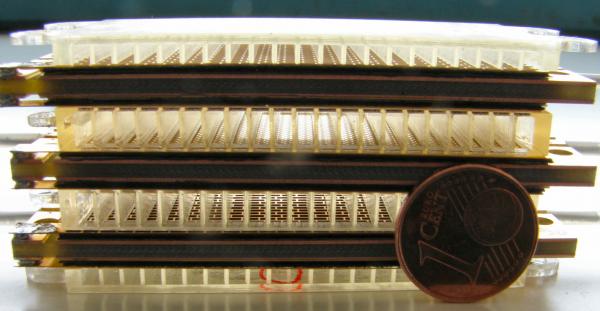In the near future, an unmanned mini-helicopter will be able to locate survivors in the ruins of buildings or examine contaminated areas. This mini-helicopter will be powered by a very light fuel cell weighing 30 grams and supplying 12 watts

In the near future, an unmanned mini-helicopter will be able to locate survivors in the ruins of buildings or examine contaminated areas. This mini-helicopter will be powered by a very light fuel cell that weighs 30 grams and delivers 12 watts.
In order to supply enough energy, several fuel cells must be connected in series. The manufacturers generally attach the cells to an integrated array containing several metal surfaces, each of which has a separate channel for air and another for hydrogen. Such a combination makes the array quite heavy. Researchers from the University of Berlin succeeded in developing a fuel cell that weighs only 30 grams and has a power of 12 watts.
Until now, such a high ratio of 400 watts per kilogram could only be achieved in very large systems weighing hundreds of grams. The fuel cell is light enough to propel a 20-centimeter helicopter. This helicopter could be used in the future for the tasks of locating survivors in the ruins of buildings, monitoring traffic on the roads and examining areas contaminated by chemical accidents. How did the researchers manage to reduce the weight of the cells so sharply? "We used extremely thin surfaces of fuel cells," explains the head of the research, Dr. Robert Hahn. "We replaced the metal surfaces with light plastic components." The researchers have no need for an additional pump to supply the desired amount of air: the wind received by the propeller blades of the helicopter is flowed directly through the air vents.
The researchers were also required to find a solution for the hydrogen supply, since a normal pressure tank would be too heavy for the helicopter. "We built a small reactor containing solid sodium borohydride. If water is poured into the mop, hydrogen is obtained," explains the lead researcher. Since the energy requirements that the helicopter needs to stay in the air are uniform, the booster must produce a constant amount of hydrogen. The researchers have already built a prototype of this type of lightweight fuel cell. The helicopter is supposed to take off, powered by this fuel cell only, already within the next year. For the scientists the next step is to adapt the production of hydrogen through a variable energy supplier. Another use for such a fuel cell is a charging point for computers and mobile phones.
to the notice of the researchers

One response
I have such a tiny helicopter on a remote and believe me, this toy is really crazy addicting